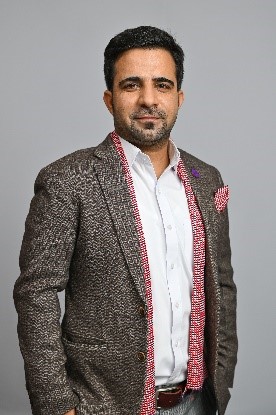
Syed Ahmed Shah, PhD, Department of Biosystems and Soft Matter, IPPT PAN, is conducting a research project titled “Biopolymer based Enzyme-mediated fast in situ injectable hydrogels laden with Curcumin nanocrystals for bone tissue engineering”. The project is being implemented as part of the PASIFIC program, organized by the Polish Academy of Sciences. It targets scientists from abroad who wish to conduct research in Poland. Fellows receive a research budget and maintenance support for the 2-year duration of the project. The program aims to increase the interest of international researchers in conducting scientific research in Poland.
Biography
Syed Ahmed Shah started his research journey working on the development, characterization, and in vivo evaluation of stimuli-responsive hydrogels, exploring their wide-ranging applications in biomedicine and clinical applications. In 2022, he obtained a Ph.D. in Pharmacy from COMSATS University Islamabad, Pakistan. Recognizing his dedication and passion for increasing the translation of the novel ideas and concepts into tangible advancements in the biomedical sciences, S.A. Shah was honored with the Research Excellence Award 2022 by the Superior University, Pakistan. Moreover, his commitment to groundbreaking research was acknowledged in 2020 when the Higher Education Commission of Pakistan granted him a travel stipend to develop his doctoral experience at the University of Twente, The Netherlands.
Carrying out the research under the PASIFIC-MSCA Programme, S.A. Shah is concentrated on enzyme-mediated and pH-responsive hydrogel for accelerated bone regeneration and repair, controlled drug delivery, bone tissue engineering (BTE), and bio-based polymeric systems for de novo bone formation, and to assemble functional constructs that synergistically promote the healing of damaged bone tissues.
Research problem
Bone tissue possesses an inherent ability to regenerate itself to some extent, but severe defects can sometimes interrupt this regenerative process. These bone defects have sparked innovative solutions that use biomaterials, including scaffolds, bone ceramics, and composite materials. However, these cutting-edge materials still face significant challenges: limited integration with host tissue, inherent brittleness, susceptibility to infection, and insufficient mechanical strength. Despite advancements in biomaterial technology, these limitations remain significant challenges in bone tissue engineering and regeneration.
Project Aims
Bone tissue has an intrinsic regenerative capability to make up deformations, but healing a severe bone defect involves the tedious and multistep process regulated by the interactions between biological and physiochemical factors, including growth factors, cells, biomechanical strength, and the extracellular matrix. The worldwide incidence of bone disorders has trended steeply upward and is expected to double by 2024, especially in populations where aging is coupled with increased obesity and poor physical activity. According to a study, every woman out of 4 and man out of 5 is affected by bone diseases. It has been reported that 60% of patients examined by knee arthroscopy exhibit bone defects and cartilage damage, whereas ~15% of people over 60 years old have some clinical symptoms of bone diseases. Additionally, each year, an estimated 1.5 million individuals suffer a fracture due to bone disease. Across the globe, an osteoporotic fracture is estimated to occur every 3 seconds.
In situ forming injectable hydrogels have recently achieved tremendous attention in bone remodeling, as they were considered to be the quality alternative to those applied after surgical intervention and can synergistically promote the healing of defective bones. In our project, we stepped towards an approach to develop biomimetic polymer-based curcumin nanocrystals (Cur-NCs) for controlled and targeted delivery in bone defect models to increase the proliferation and remodeling of bone tissue. Moreover, these Cur-NCs will be loaded in the bioactive polysaccharides-based in situ injectable hydrogels. The incorporation of bioactive polymers will be selected based on structural similarity to the constituent of the ECM in bone tissue and mechanical strength. These biomimetic injectable hydrogels can potentially promote matrix deposition and provide a conducive environment for osteocyte differentiation and proliferation. In addition, the osteocytes will also be encapsulated in the hydrogel system in vitro to evaluate the cell survival and cytotoxicity determination.
.

Figure: Supramolecular enzymatically crosslinked (by HRP and hydrogen peroxide) injectable hydrogel for bone tissue engineering in intramedullary femoral defect, illustrating a bone defects regeneration.
Game-changing solution
In situ forming injectable hydrogels have recently achieved tremendous attention in bone remodeling, as they were considered to be the quality alternative to those applied after surgical intervention and can synergistically promote the healing of defective bones. Biopolymer-based hydrogels are proven as the promising bone supportive system for bone tissue engineering employing drug delivery, stimuli responsiveness, and adaptation to the microenvironments of the defective area, and also function as biomolecules for tissue repair and remodeling.
How does the solution make people’s lives better?
After the administration of biopolymer-based hydrogel, favorable osteocytes regeneration with good osteoblasts and osteoclasts morphology will appear, and a significant healing cascade will potentiate better bone repair. The hydrogels can provide a natural hydrophilic three-dimensional environment conducive to cell survival and support new bone growth. Hydrogels can be tailored to obtain the desired geometry for implantation or injection, and the degradation rate and porosity or release profile can be easily controlled by altering the crosslinking method and degree.
______________
This project has received funding from the European Union’s Horizon 2020 research and innovation programme under the Marie Skłodowska-Curie grant agreement No 847639 and from the Ministry of Science and Higher Education

















